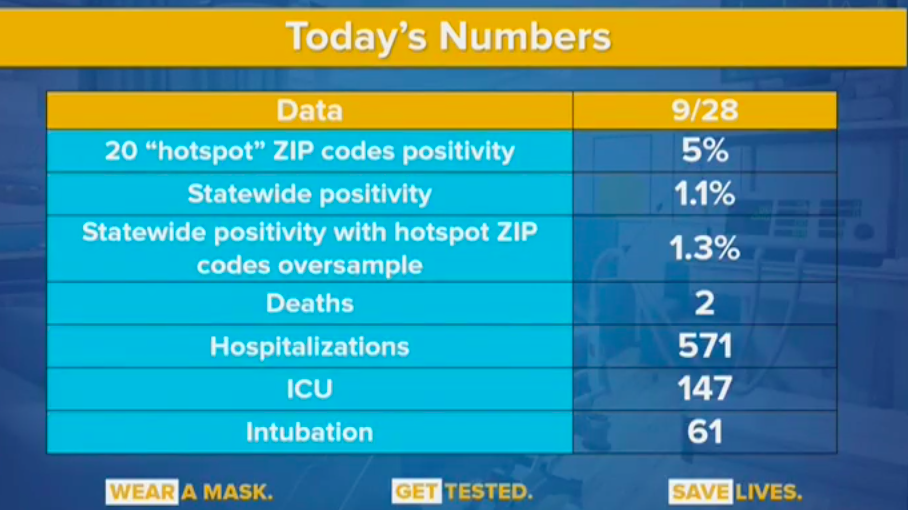'Little Pocket' On LI Among Virus Clusters Concerning Cuomo
LONG ISLAND, NY — Gov. Andrew Cuomo this week warned clusters of coronavirus cases are popping up across the state, including on Long Island, in New York City and in the Hudson Valley, with some ZIP codes reporting infection rates of up to 18 percent.
Cuomo struck a different tone Tuesday, labeling 20 ZIP codes as hot spots, including in Rockland County, Orange County, Brooklyn and a "little pocket in Nassau and Queens."
"And in these ZIP codes we're seeing very high infection rates," Cuomo told NY1.
Statewide, 1.3 percent of coronavirus tests come back positive Monday for COVID-19, the disease caused by the coronavirus. But that number dropped to 1.1 percent when excluding the 20 ZIP codes with the highest rates.
"We have about a 1 percent infection rate statewide, and we can have 5 percent, 10 percent, even 18 percent in some of these zip codes," Cuomo said. "If you don't stop a cluster, the cluster becomes community spread; so this is the early warning system. But we have to jump on those clusters, and we need real compliance and enforcement in those clusters."
Long Island had a 1.2 percent infection rate based on Monday's tests, he said. That was just 0.1 percentage points lower than the 1.3 percent seen in western New York — which Cuomo has said was under a "caution flag" in recent weeks — as well as New York City. The Hudson Valley sat at 2 percent.
Cuomo did not elaborate on the Nassau clusters that he mentioned. In a separate coronavirus briefing Tuesday, he mentioned the following Queens ZIP Codes:
Rego Park, Queens (11375) - 5 percent
Far Rockaway, Queens: (11691) - 4 percent
Jamaica, Queens, (11432) - 3 percent
East Elmhurst, Queens (11370) - 3 percent
"These are embers that are starting to catch fire in dry grass," Cuomo said. "Send all the firefighting equipment and personnel to those embers and stamp out the embers right away. That's what this data does."

Cuomo said he plans to meet virtually with Orthodox Jewish leaders Tuesday and Wednesday to address clusters in downstate communities.
"If you look at Rockland and Orange and Brooklyn and Nassau, you'll see the zip codes have a high predominance of the Orthodox Jewish community and there have been pictures that have been circulating about lack of compliance at religious ceremonies," Cuomo said. "Religious ceremonies are only by law 50 percent of capacity, but I'm going to say to the leaders in Orange and Rockland and Brooklyn the law is there to protect you and the local officials are supposed to be enforcing it, and we need the help of the community."
On Long Island, the state has recorded 21 positive cases based on home address among school-age children since Sept. 1 within the confines of Great Neck Public Schools. That includes 14 from Sept. 15-28 and six from Sept. 22-28. The public school district accounted for one of those cases, according to state records. That's because a school district may serve families who do not live within the district boundaries and staff may come from other adjacent counties. That number may also include students living within the district but who attend private schools or charter schools, which aren't operated by the district.
Great Neck Estates and Saddle Rock Estates were among a short list of areas that saw the seven-day daily average number of cases increase by at least 0.2, according to Newsday's tracker. The newspaper's tracker identified Inwood, Lawrence, Woodsburgh, Cedarhurst and Point Lookout as seeing upticks in daily coronavirus case rates as of Sunday.
The governor urged local governments to enforce mask-wearing compliance, including among religious groups and gatherings.
New York will also create a New York City Stabilization and Recovery Program aimed at addressing the current coronavirus crisis and later recovering long-term. The stabilization side of the program will look at schools, crime, economy, cleanliness and homelessness. On the recovery side, the state must first determine how many major changes and disruptive patterns are permanent.
Cuomo said: "You have people working from home, people who don't want to go into the office, people who are living in other places, is that short term or is that long term? When do they come back or have they just readjusted their lifestyle, so they're saying 'I'm not going back to the office five times a week and I'm not having my employees come back, I like it better.' They give up the office space, they work from home or some hybrid. We don't know. We have to assess that and I also think there are some factors that will still be calibrated in that equation and one of them is when you get a vaccine."
This article originally appeared on the Long Island Patch

